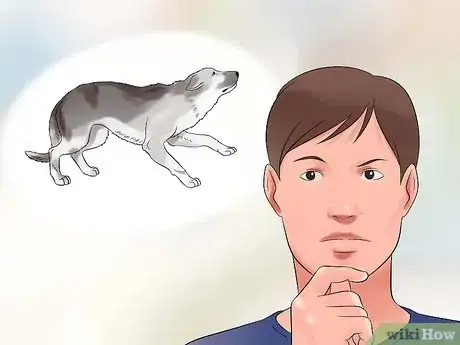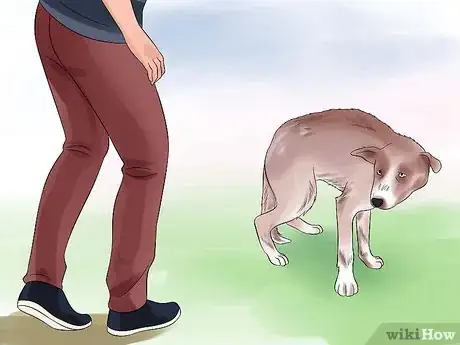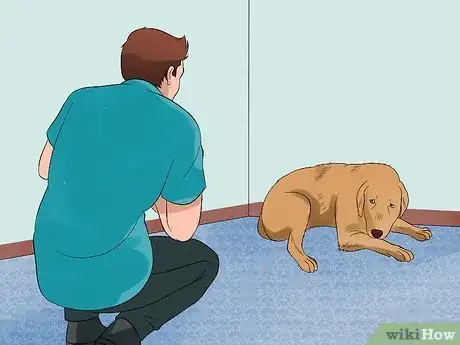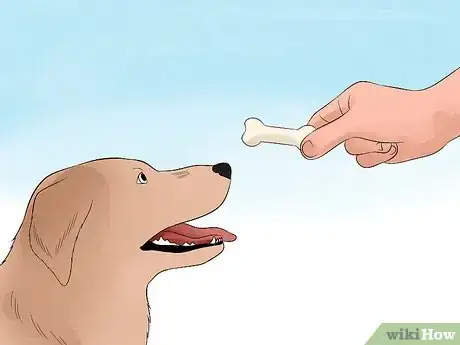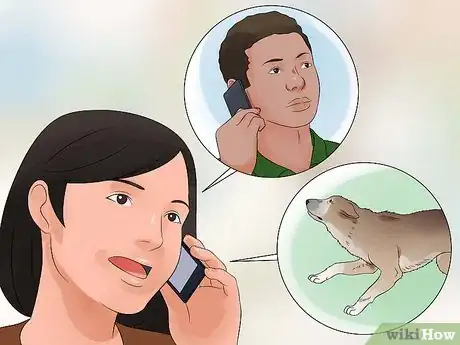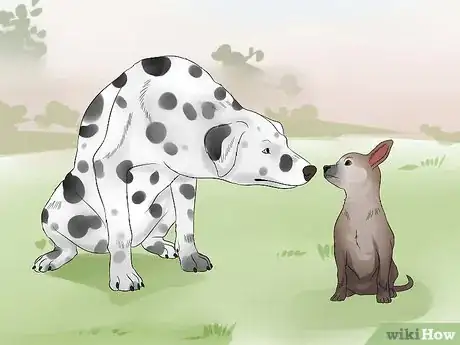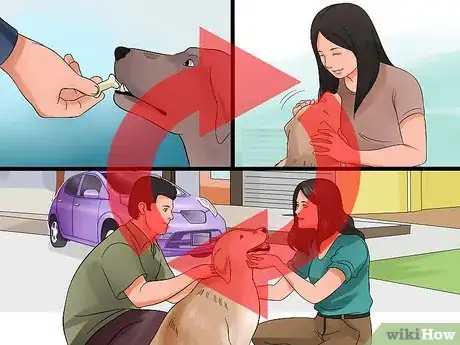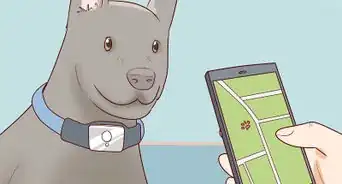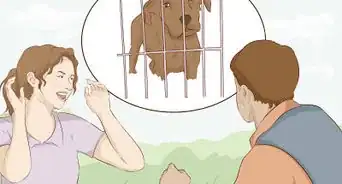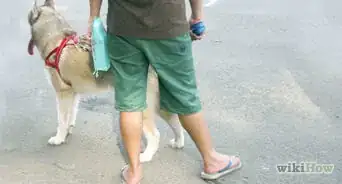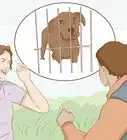This article was co-authored by Rendy Schuchat. Rendy Schuchat is a Certified Professional Dog Trainer and the Owner of the largest dog training facility, Anything Is Pawzible, based in Chicago, Illinois. With over 20 years of experience, Rendy specializes in positive dog training and behavior modification to help people build and strengthen their relationships with their dogs. She holds a BA in Psychology and Communications from the University of Iowa, an MA in Psychology from Roosevelt University, and a Certification in Dog Obedience Instruction from Animal Behavior Training and Associates. Rendy was voted one of the Best/Favorite Dog Trainers in Chicago by Chicagoland Tails Reader’s Choice Awards multiple times and was voted Chicago Magazine’s “Best Dog Whisperer” in 2015.
There are 11 references cited in this article, which can be found at the bottom of the page.
This article has been viewed 141,396 times.
If you encounter a stray or runaway dog, or have adopted a rescued animal, there is a good chance that dog may show signs of fear or anxiety. Sometimes an otherwise gentle dog will act violently when it is shy or frightened, though shy dogs tend to be more easily calmed than fearful dogs. Whether you are helping someone find a lost dog, trying to calm a newly-adopted dog, or just trying to approach an animal on the street to offer it assistance, knowing the signs of a frightened dog and how to approach it safely can make a world of difference.
Steps
Recognizing a Fearful Dog
-
1Understand dog behavior. There are a number of reasons why a dog might be frightened around people. It's possible that you haven't done anything wrong to provoke this reaction from a dog; sometimes dogs are fearful of humans because they need to be in order to survive.
- Some dogs are fearful around humans because of previous or ongoing abuse. It's possible a fearful dog you encounter is hurt, and is acting aggressively so that he does not appear weak and vulnerable.[1]
- NEVER approach an injured animal that you do not know. It is very likely that the animal may perceive you as a threat and attack to defend itself.
-
2Recognize body language. A frightened dog may tense up his body, and raise his hackles (the row of hair along the dog's back). If a dog you are approaching turns suddenly, locks his body into a firm position, and has raised hair on its back, it's best to stop where you are and let the dog see that you are not a threat to him.[2]Advertisement
-
3Don't look the dog in the eyes. An anxious dog can sometimes be triggered by direct eye contact—the dog might see it as you asserting dominance. Any time a frightened dog stares at you, you should avert your eyes to show the dog that you are respecting their boundaries.[3]
- It can help to even turn your head or shoulder away from the dog.[4]
-
4Look for teeth and/or growling. Bared teeth and growling are two of the biggest tell-tale signs that a dog feels threatened or uneasy, and may attack if you proceed.[5] Growling does not necessarily mean that the dog will attack you, but it does mean that he may attack if you continue to make him feel threatened.[6]
Identifying Fear Triggers
-
1Determine what is upsetting the dog. It's possible that you are the cause of a frightened dog's anxiety. But it could also be that the dog is bothered by something in his immediate environment, and your presence is not a factor in his fear.[7]
- Always assume that you might be the stimulus that is causing a dog to feel frightened or nervous, especially if it is not a pet you are familiar with.
-
2Observe what may be frightening the dog. If it's a dog you know and encounter regularly, you may observe multiple situations or stimuli that seem to upset the dog. Understanding what triggers this response can help you avoid those triggers, or expose the dog to those triggers in a controlled environment.[8]
- If you know the dog, scan your surroundings for things that might be upsetting the animal. Things that we take for granted, like a certain sound, a foreign object in the yard or house, or a new and unfamiliar odor, could cause a dog to act fearful or nervous.[9]
- If the dog belongs to you or someone you know and you suspect that an environmental change is the reason the dog is upset (a vacuum cleaner, for example, or a new piece of furniture), expose the dog to that new element in short, controlled sessions. Allow the dog to become familiar with that object and to recognize, in his own time, that the object is not a threat.[10]
- Examine the dog for injuries from a safe distance. Do not force close contact. Take note of whether the dog is limping or hiding one side from you, keeping his ears flat against his head, excessively licking an injured area, or whimpering.[11]
-
3Do not further frighten the dog. Approaching carefully, and knowing when to back away, are crucial for a successful interaction with a shy or frightened dog. Remember that if the dog does not know you, he may perceive you as a threat.[12]
Calming a Fearful Dog
-
1Be aware of your own body language. Animals pick up on body language much more sharply than humans do. If a dog is shy or fearful, especially a dog you do not know, managing your own body language may be the most important thing you can do to calm and reassure a frightened dog.[13]
- Never approach a frightened dog head-on or stare at it. Approach from the side, looking at him with your peripheral vision, so that the dog does not think you are approaching him with malicious intentions.[14]
- Move slowly around a frightened dog. If you move in a quick, jerky way, it could make the dog more anxious.[15]
- Consider sitting when the dog is around—this will make you appear smaller, which could help put the dog at ease.[16]
- Do not reach out to the dog. Hold out your open hand from a safe distance, and allow the dog to choose whether or not he wants to approach you.[17]
- If the dog has an owner nearby, always ask the owner's permission before approaching the dog, and wait for the owner's response.[18]
-
2Show respect and praise calm behavior. Move slowly around the dog, and verbally praise him if he appears to be willing to approach you. This will let the dog know that you respect his boundaries, but are willing to offer him praise and kindness if he is willing to get closer.
- Speak softly. Never raise your voice around a frightened animal.[19]
-
3Give the dog his space. Every dog has a "safety zone," an area around him which he will not allow strangers to enter if they could pose a threat. Remain a safe distance away, and do not approach the dog or enter his safety zone if he is showing signs of frightened aggression.[20]
- There is no absolute when it comes to a dog's safety zone. Every dog is different. Cautious trial and error is the only way to determine a dog's boundaries.[21]
-
4Offer treats if it's safe. If you or someone you know owns the dog, consider offering treats to the dog as a reward for behaving calmly around you. Praise him every time he comes up to you without hesitation, and offer him a treat, if it's okay with his owner.[22]
- Don't approach the dog with the food—let the dog approach you, instead.[23]
- This should only be done if you know the dog and are certain he does not have food aggression issues. Offering food to a dog with these issues could provoke further aggressive behavior.
-
5Call animal control. If you believe you've found a dog that may be lost or injured, the best thing to do is to call animal control. In rural areas without an autonomous animal control department, you should call the police.[24]
- Give your contact information to the animal control or police dispatcher, so they know how to contact you in case of any further developments.[25]
- Give the dispatcher your precise location so that the responders can locate you easily.[26]
- Ask for a time estimate on when someone will arrive. If it will be a long time, the dispatcher may ask you to remain near the dog, or to follow and observe him from a safe distance.[27]
Recognizing and Calming a Shy Dog
-
1Understand why dogs are shy. There are a number of reasons why a dog may be excessively shy around people.
-
2Expose dogs slowly. If your dog is shy whenever he meets new people, expose him gradually, but make sure that he is having exposure.
- If your dog clings to you whenever other people are around, try to ignore his pleas for attention. Eventually your dog will realize that he will not be rewarded with attention or affection until he is willing to interact with other people.
-
3Try socializing him with another dog. Some dogs are shy because they never learned how to interact with people. If your dog is shy of humans but gets along well with other dogs, try having your shy dog spend time with a more social dog. Your dog may, over time, learn from his canine companion how to behave around humans.
-
4Have someone the dog is shy around offer food. Once the dog has shown some progress in being around other people, have someone he is becoming more comfortable around offer him food. This should only be done with dogs that do not exhibit signs of food aggression, for the safety of all parties involved.
- Have the person crouch low or sit on the floor.
- While avoiding eye contact, have the person hold out the dog's bowl with food in it.
- Do not force the dog to come eat; let the dog come when he is ready.
-
5Be patient and consistent. Reward your dog with treats and verbal praise every time he comes out of his shell enough to interact with other people. Rewards should be given immediately, to help establish the reward as being related to his behavior.
Expert Q&A
Did you know you can get expert answers for this article?
Unlock expert answers by supporting wikiHow
-
QuestionDoes hot weather make anxious dogs worse? My Aussie is more clingy and skittish than ever in the heat.
 Pippa Elliott, MRCVSDr. Elliott, BVMS, MRCVS is a veterinarian with over 30 years of experience in veterinary surgery and companion animal practice. She graduated from the University of Glasgow in 1987 with a degree in veterinary medicine and surgery. She has worked at the same animal clinic in her hometown for over 20 years.
Pippa Elliott, MRCVSDr. Elliott, BVMS, MRCVS is a veterinarian with over 30 years of experience in veterinary surgery and companion animal practice. She graduated from the University of Glasgow in 1987 with a degree in veterinary medicine and surgery. She has worked at the same animal clinic in her hometown for over 20 years.
Veterinarian Dogs are far more sensitive to changes in atmospheric pressure than people. This can alert them to changes in the weather long before we become conscious of it. They can also hear thunderstorms several miles away, so in hot, heavy weather, it's possible a dog may pick up on thunder and lightning some distance away, which may be unsettling and cause anxiety. As to hot weather specifically, all dogs are individuals, and some become depressed when the weather's hot, so being clingy in the heat is a possibility.
Dogs are far more sensitive to changes in atmospheric pressure than people. This can alert them to changes in the weather long before we become conscious of it. They can also hear thunderstorms several miles away, so in hot, heavy weather, it's possible a dog may pick up on thunder and lightning some distance away, which may be unsettling and cause anxiety. As to hot weather specifically, all dogs are individuals, and some become depressed when the weather's hot, so being clingy in the heat is a possibility. -
QuestionHow should I greet an anxious dog?
 Rendy SchuchatRendy Schuchat is a Certified Professional Dog Trainer and the Owner of the largest dog training facility, Anything Is Pawzible, based in Chicago, Illinois. With over 20 years of experience, Rendy specializes in positive dog training and behavior modification to help people build and strengthen their relationships with their dogs. She holds a BA in Psychology and Communications from the University of Iowa, an MA in Psychology from Roosevelt University, and a Certification in Dog Obedience Instruction from Animal Behavior Training and Associates. Rendy was voted one of the Best/Favorite Dog Trainers in Chicago by Chicagoland Tails Reader’s Choice Awards multiple times and was voted Chicago Magazine’s “Best Dog Whisperer” in 2015.
Rendy SchuchatRendy Schuchat is a Certified Professional Dog Trainer and the Owner of the largest dog training facility, Anything Is Pawzible, based in Chicago, Illinois. With over 20 years of experience, Rendy specializes in positive dog training and behavior modification to help people build and strengthen their relationships with their dogs. She holds a BA in Psychology and Communications from the University of Iowa, an MA in Psychology from Roosevelt University, and a Certification in Dog Obedience Instruction from Animal Behavior Training and Associates. Rendy was voted one of the Best/Favorite Dog Trainers in Chicago by Chicagoland Tails Reader’s Choice Awards multiple times and was voted Chicago Magazine’s “Best Dog Whisperer” in 2015.
Certified Professional Dog Trainer
-
QuestionCan I give a treat to a dog that's anxious?
 Rendy SchuchatRendy Schuchat is a Certified Professional Dog Trainer and the Owner of the largest dog training facility, Anything Is Pawzible, based in Chicago, Illinois. With over 20 years of experience, Rendy specializes in positive dog training and behavior modification to help people build and strengthen their relationships with their dogs. She holds a BA in Psychology and Communications from the University of Iowa, an MA in Psychology from Roosevelt University, and a Certification in Dog Obedience Instruction from Animal Behavior Training and Associates. Rendy was voted one of the Best/Favorite Dog Trainers in Chicago by Chicagoland Tails Reader’s Choice Awards multiple times and was voted Chicago Magazine’s “Best Dog Whisperer” in 2015.
Rendy SchuchatRendy Schuchat is a Certified Professional Dog Trainer and the Owner of the largest dog training facility, Anything Is Pawzible, based in Chicago, Illinois. With over 20 years of experience, Rendy specializes in positive dog training and behavior modification to help people build and strengthen their relationships with their dogs. She holds a BA in Psychology and Communications from the University of Iowa, an MA in Psychology from Roosevelt University, and a Certification in Dog Obedience Instruction from Animal Behavior Training and Associates. Rendy was voted one of the Best/Favorite Dog Trainers in Chicago by Chicagoland Tails Reader’s Choice Awards multiple times and was voted Chicago Magazine’s “Best Dog Whisperer” in 2015.
Certified Professional Dog Trainer
Warnings
- If a fearful dog growls, it is a sign that he is uncomfortable. Do not punish growling! Instead, calmly walk away to diffuse the situation, then engage the services of a qualified professional trainer.⧼thumbs_response⧽
References
- ↑ http://www.2ndchance.info/fearfuldog.htm
- ↑ http://bestfriends.org/Resources/Meeting-Fearful-Dogs-Safely/
- ↑ Rendy Schuchat. Certified Professional Dog Trainer. Expert Interview. 26 January 2021.
- ↑ Rendy Schuchat. Certified Professional Dog Trainer. Expert Interview. 26 January 2021.
- ↑ http://bestfriends.org/Resources/Meeting-Fearful-Dogs-Safely/
- ↑ http://www.dogstardaily.com/training/fearful-growling
- ↑ http://www.2ndchance.info/fearfuldog.htm
- ↑ http://www.whole-dog-journal.com/issues/9_4/features/Dog_Behavior_15800-1.html
- ↑ http://www.2ndchance.info/fearfuldog.htm
- ↑ http://www.2ndchance.info/fearfuldog.htm
- ↑ http://www.vcahospitals.com/main/pet-health-information/article/animal-health/pain-management-for-dogs/848
- ↑ http://bestfriends.org/Resources/Meeting-Fearful-Dogs-Safely/
- ↑ http://bestfriends.org/Resources/Meeting-Fearful-Dogs-Safely/
- ↑ http://drsophiayin.com/blog/entry/preventing-dog-bites-by-learning-to-greet-dogs-properly
- ↑ Rendy Schuchat. Certified Professional Dog Trainer. Expert Interview. 26 January 2021.
- ↑ Rendy Schuchat. Certified Professional Dog Trainer. Expert Interview. 26 January 2021.
- ↑ http://drsophiayin.com/blog/entry/preventing-dog-bites-by-learning-to-greet-dogs-properly
- ↑ http://drsophiayin.com/blog/entry/preventing-dog-bites-by-learning-to-greet-dogs-properly
- ↑ http://www.hsi.org/assets/pdfs/eng_approach_unknown_dog.pdf
- ↑ http://drsophiayin.com/blog/entry/preventing-dog-bites-by-learning-to-greet-dogs-properly
- ↑ https://www.msu.edu/~silvar/fear.htm
- ↑ https://www.aspca.org/pet-care/virtual-pet-behaviorist/dog-behavior/fear-people
- ↑ Rendy Schuchat. Certified Professional Dog Trainer. Expert Interview. 26 January 2021.
- ↑ http://www.humanesociety.org/animals/resources/tips/what_to_do_stray_pet.html
- ↑ http://www.humanesociety.org/animals/resources/tips/what_to_do_stray_pet.html
- ↑ http://www.humanesociety.org/animals/resources/tips/what_to_do_stray_pet.html
- ↑ http://www.humanesociety.org/animals/resources/tips/what_to_do_stray_pet.html
- ↑ http://www.2ndchance.info/fearfuldog.htm
- ↑ http://www.2ndchance.info/fearfuldog.htm
About This Article
To approach a shy or fearful dog, approach it from the side instead of head on so it doesn't feel threatened. Also, avoid staring at the dog since dogs view staring as a threat or sign of dominance. As you approach the dog, move slowly and cautiously so you don't frighten it. You may also want to crouch down so you appear smaller and less intimidating. For more advice from our Veterinary co-author, like how to calm a fearful dog, scroll down.
